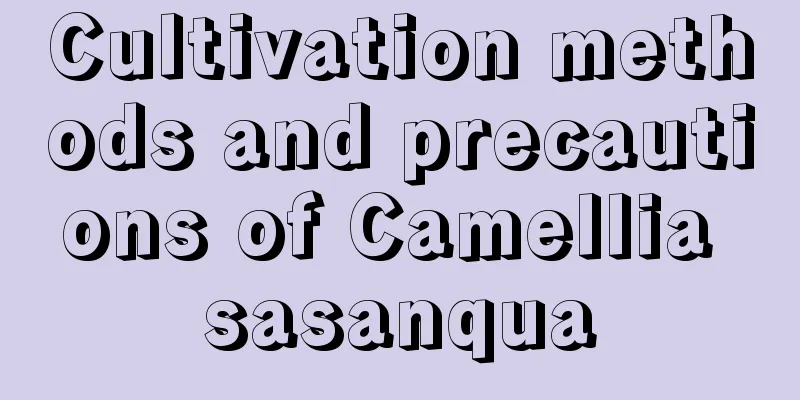Cultivation methods and precautions of Camellia sasanqua

|
Camellia sasanqua is an evergreen small tree of the Theaceae family Camellia genus, but it is different from the camellia we usually call. It is a semi-sun-loving and semi-shade-loving plant and has strong shade tolerance, but long-term exposure to a dark environment may result in no flowering or less flowering. Let’s learn about the cultivation methods and precautions of Camellia sasanqua. 1. Soil selection Camellia sasanqua is suitable for growing in loose, fertile, well-drained acidic sandy soil with a pH value between 5.5-6.5. When potting in northern regions, you can choose a culture soil composed mainly of leaf mold or peat soil, with a small amount of river sand added. A small amount of well-rotted compost or organic fertilizer can be added to leaf mold, perlite , river sand, etc. to increase the nutrients in the soil. 2. Lighting management Camellia sasanqua is a semi-shade plant and is suitable for growing under soft light. In summer, shade is needed to avoid strong sunlight. In late autumn and winter, more sunlight is needed. You can choose to expose it to light in the morning or evening, avoiding direct sunlight. 3. Watering tips Water when the soil is dry and wet, and water thoroughly. Avoid watering in the middle. In summer, water the plants once in the morning and evening every day, and in winter, water them once every few days. Except in winter, you should spray water on the leaves every few days to keep them clean. 4. Fertilization method Generally, apply thin nitrogen fertilizer 1-2 times in February and March to promote the growth of branches and leaves; apply thin cake fertilizer water once in April and May to promote flower bud differentiation; apply phosphorus fertilizer once in September and October to make the flowers larger and more colorful. Fertilizer should be light and fully decomposed, avoid applying raw or concentrated fertilizer. 5. Trimming After the flowers fade, remove the remaining flowers in time to reduce nutrient consumption. Generally, one flower bud is left on each branch, and the rest are thinned out to concentrate the nutrients. 6. Notes Although Camellia sasanqua likes sunlight, it cannot be exposed to direct sunlight, otherwise it will cause leaf burns. During the growing period, the soil needs to be kept moist, but not too moist to avoid root rot. The suitable temperature for growth is between 18-25℃. Too low or too high temperature will have an adverse effect on its growth. Camellia sasanqua has relatively few diseases and pests, the main diseases include gray spot, sooty mold, anthracnose, etc., which must be prevented and controlled in time. In short, the soil of Camellia sasanqua needs to be changed every 2-3 years, because the soil in the pot tends to become compacted, affecting the growth of the plant. Changing the soil can also prevent soil alkalinity, and prune the roots when changing the soil to promote plant growth
|
<<: The breeding methods and precautions of Jinyumantang
>>: Fuchsia cultivation methods and precautions
Recommend
The cultivation method of white flower gentian
1. Soil White flowered gentian is more suitable f...
If you want flowers to grow faster, just do one little thing!
1. Tips for growing asparagus fern quickly 1. Fer...
What is the current prospect of flower planting in rural areas? (Which flowers are the most profitable to plant in rural areas?)
What is the prospect of planting flowers in rural...
What flower has the best meaning and symbolism?
1. Rose This flower has always been a symbol of l...
This is how you should grow succulents. They will be as juicy as jelly and children will rush to eat them when they see them!
How does Jade Dew become crystal clear? If you wa...
Pepper seedling raising time
Chili pepper is an indispensable condiment on the...
Advantages and disadvantages of Mr. Lincoln rose
Mr. Lincoln rose is known as the king of roses, a...
How to grow succulent flowers so that they can bloom
1. Choose the right variety If you want to grow s...
How to germinate loquat seeds
1. Wash first It is relatively easy to germinate ...
What flowers are suitable for balcony flower boxes? Four classic balcony flower boxes for planting flowers
What flowers are suitable for balcony flower boxe...
What to do if the fairy finger is too long
reason Generally speaking, there are three possib...
How to grow moss on banyan bonsai? Will it affect the ventilation of the bonsai?
1. How to grow moss on banyan bonsai Keep moist: ...
What should I do if the succulent leaves suddenly fall off?
1. Treatment methods Generally, if all the leaves...
How to grow roses in a vase
1. Prepare the vase When growing it in a vase, of...
What is garden soil?
Garden Soil Introduction Garden soil, also known ...









